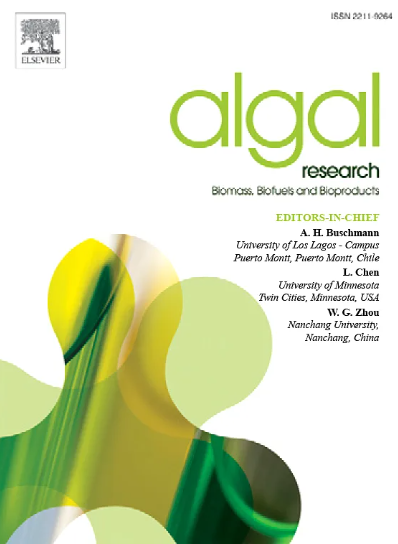Nutrient screening of Chlorella vulgaris and C. variabilis using high-throughput biolog phenotype arrays
IF 4.6
2区 生物学
Q1 BIOTECHNOLOGY & APPLIED MICROBIOLOGY
Algal Research-Biomass Biofuels and Bioproducts
Pub Date : 2024-10-09
DOI:10.1016/j.algal.2024.103740
引用次数: 0
Abstract
Microalgae, particularly Chlorella species, are versatile microorganisms with significant scientific potential in various domains, including recombinant protein production, wastewater treatment, biofuel production, bio-fertilizers, food source, pharmaceuticals, and carbon capture. However, conventional growth media have often been the default choice for Chlorella cultivation. This study utilizes Biolog phenotype array plates to explore the growth responses of Chlorella vulgaris and Chlorella variabilis to a broad spectrum of carbon, nitrogen, phosphorus, and sulfur sources. The growth dynamics were captured by integrating the area under the OD-time curve. The results revealed growth preferences for both Chlorella species, emphasizing their unique nutrient source requirements and illuminated some unexpected growth behaviors. C. vulgaris exhibited equal preference for trehalose as glucose, and C. variabilis was unable to metabolize nitrate or sucrose, two staples of modified BBM media most commonly used for its cultivation. These findings contribute to a deeper understanding of the metabolic capacities of C. vulgaris and C. variabilis, informing potentially more efficient and tailored microalgal cultivation practices across diverse applications.
利用高通量生物表型阵列对普通小球藻和变异小球藻进行营养筛选
微藻类,尤其是小球藻物种,是一种多功能微生物,在重组蛋白质生产、废水处理、生物燃料生产、生物肥料、食物来源、制药和碳捕获等多个领域具有巨大的科研潜力。然而,传统的生长培养基往往是培养小球藻的默认选择。本研究利用 Biolog 表型阵列板来探索小球藻和变异小球藻对各种碳、氮、磷和硫源的生长反应。生长动态是通过整合 OD-时间曲线下的面积来捕捉的。结果显示了两种小球藻的生长偏好,强调了它们对营养源的独特需求,并揭示了一些意想不到的生长行为。C. vulgaris 对三卤糖和葡萄糖表现出同样的偏好,而 C. variabilis 无法代谢硝酸盐或蔗糖,而这两种物质是最常用于其培养的改良 BBM 培养基的主要成分。这些发现有助于加深对 C. vulgaris 和 C. variabilis 新陈代谢能力的了解,从而为更高效、更适合不同应用的微藻培养方法提供信息。
本文章由计算机程序翻译,如有差异,请以英文原文为准。
求助全文
约1分钟内获得全文
求助全文
来源期刊

Algal Research-Biomass Biofuels and Bioproducts
BIOTECHNOLOGY & APPLIED MICROBIOLOGY-
CiteScore
9.40
自引率
7.80%
发文量
332
期刊介绍:
Algal Research is an international phycology journal covering all areas of emerging technologies in algae biology, biomass production, cultivation, harvesting, extraction, bioproducts, biorefinery, engineering, and econometrics. Algae is defined to include cyanobacteria, microalgae, and protists and symbionts of interest in biotechnology. The journal publishes original research and reviews for the following scope: algal biology, including but not exclusive to: phylogeny, biodiversity, molecular traits, metabolic regulation, and genetic engineering, algal cultivation, e.g. phototrophic systems, heterotrophic systems, and mixotrophic systems, algal harvesting and extraction systems, biotechnology to convert algal biomass and components into biofuels and bioproducts, e.g., nutraceuticals, pharmaceuticals, animal feed, plastics, etc. algal products and their economic assessment
 求助内容:
求助内容: 应助结果提醒方式:
应助结果提醒方式:


